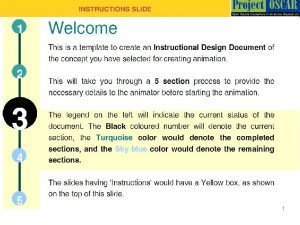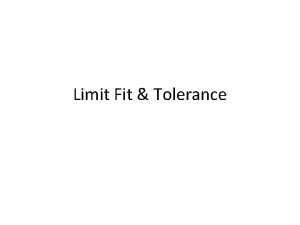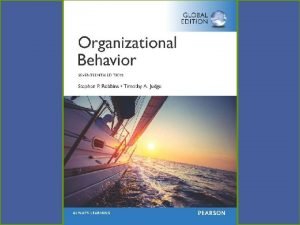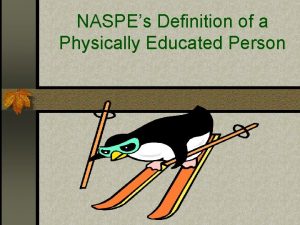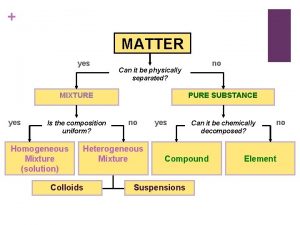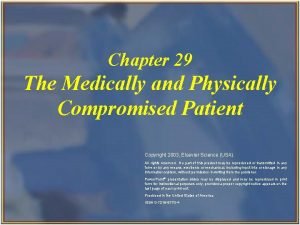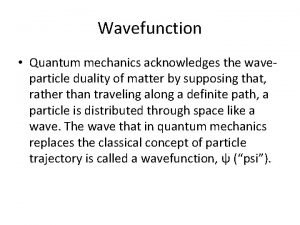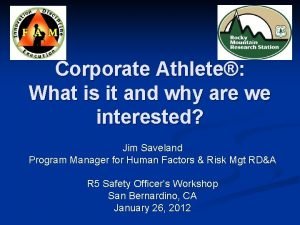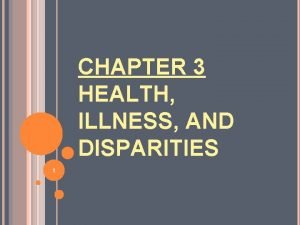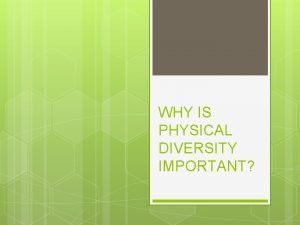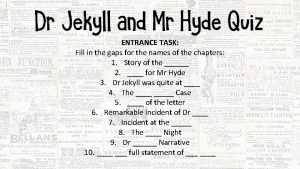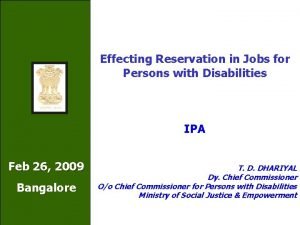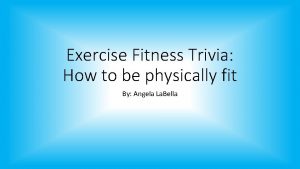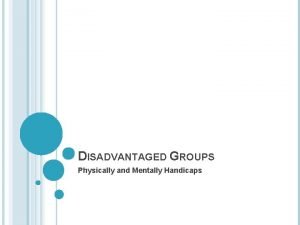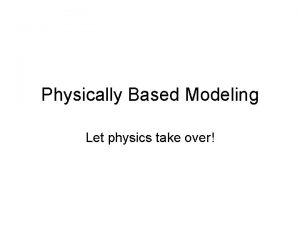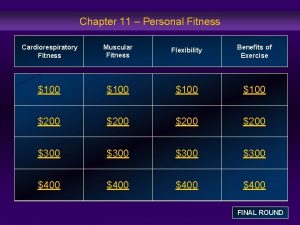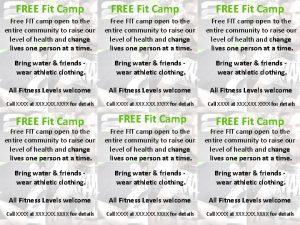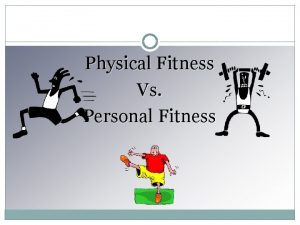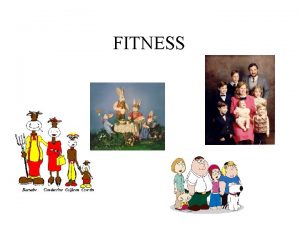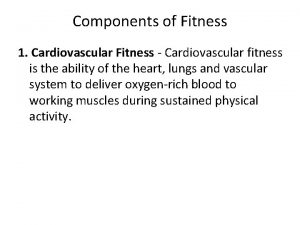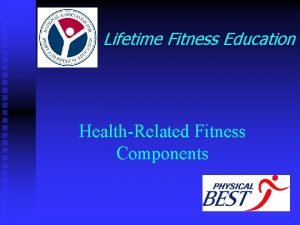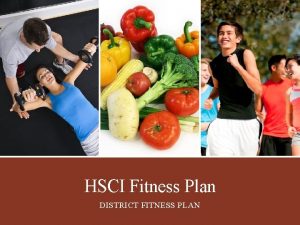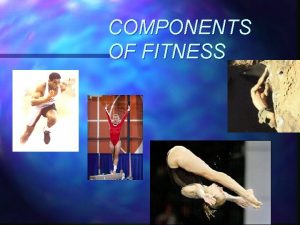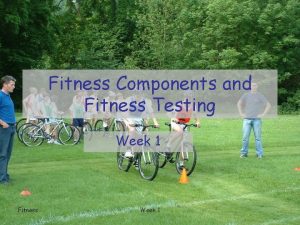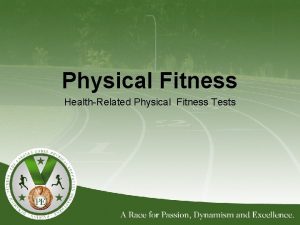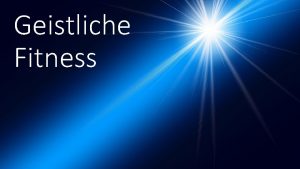Fitness Chapter 9 Are you physically fit What




















- Slides: 20

Fitness Chapter 9

Are you physically fit? What does it mean to be physically fit? l Ideas, Examples Benefits of being physically fit: l l More energy Better self-confident Better endurance Fun and entertaining

Benefits of Being Physically Fit Unfit Person – Sedentary Sitting down a lot Society enables unfit people: elevators, garage door openers, electric can openers Trouble sleeping Less chance of lifestyle diseases Healthy weight Increased stamina Muscular endurance Muscular strength Flexibility Healthy body composition

What does fitness mean? The characteristics of the body that enable it to perform physical activity. The ability to meet routine physical demands, with enough reserve energy to rise to sudden challenges. The body’s ability to withstand stress, including physiological stresses. You can achieve all of these definitions by regularly being physically active – 30 minutes on most days of the week.

How do we get fit? Conditioning – practice and training the body to be physically fit. It is not an overnight process…it takes a long time. You must be willing to create time for fitness on most days of the week. It takes about 8 weeks for it to become a routine.

5 Components of Fitness 1. Muscular Strength 2. Muscular Endurance 3. Flexibility 4. Cardiovascular Endurance 5. Body Composition

Overload Principle The stronger and more fit you are, the less you must strain to do the work. Your body responds to OVERLOAD in a positive way. Progressive Overload Principle – FITT F = frequency of activity l I = intensity of activity l T = time of activity l T = type of activity l

FITT Idea Progress slowly! Proceed with caution! Use proper equipment and attire l Exercise regularly l Train hard 1 or 2 x’s per week. In between do moderate workouts l Listen to your body l Perform activities with proper form l

Energy Balance For each 3, 500 calories you eat over the amount you spend, you store a pound of body fat. The reverse is also true. Input vs. Output Basal energy Voluntary activities

Basal Energy Heart Beat l Breathing l Body temperature l Working of nerves and glands l Supports life! A person uses up 1, 200 -1, 400 calories a day this way!

Proper Warm-Up/Cool Down Warm-Up l l Need to get body’s fuels ready Need to warm-up muscles and connective tissue Less risk of injury Walking, biking, light jogging followed by light stretching Cool-Down l l A few minutes of light activity to bring body down to resting Helps to relax muscles Allows blood to circulate freely to cool the body Get a good stretch

Gaining Cardiovascular Endurance Aerobic – demands oxygen l The more a person exercises, the more efficient they are at providing the muscles the oxygen they need Anaerobic – without oxygen l Activity that lasts just a short amount of time, but is very intense Marathon runner vs 400 m dash runner

How to gain cardiovascular benefits Aerobic and anaerobic exercise Promotes health in every body A person that has no cardiovascular endurance has a hard time doing daily living activities; walking up stairs, taking out the trash, picking up their children Most important to health and life in general

Calculating Target Heart Rate 220 – age = maximum heart rate (MHR) Target HR is approximately 65%-85% of your MHR Example: 220 -15 = 205 l 205 x 65% = 133, 205 x 85% = 174 l A 15 year old’s target heart rate is between 133 -174 beats per minute. l

Activities for Cardio Endurance Use large muscle groups like quads, hamstrings, glutes, and abdomen Be steady and constant Exercise for a constant amount of time Examples: l Walking, running, inline skating, crosscountry skiing, hiking, yoga, weight lifting, basketball, swimming, aerobic dance/step aerobics, cycling

Flexibility depends on elasticity of muscles and connective tissues and on the health of your joints Range of Motion (ROM) – how far your muscles are able to stretch Stretching – improves flexibility; stretch to the point of slight discomfort, not pain! Never stretch a COLD muscle

Muscular Strength and Endurance How do you gain muscle? Strength is the ability to work against resistance Muscular endurance is the ability for a muscle to hold a contraction for long periods of time or contract repeatedly

Strength Conditioning Have a goal in mind l l l Tone Build muscle Verbalize your goal Wt Training tips: l l l Sets Repetitions Don’t overdo it! Start slow and build into it Work muscles equally Bench press Squats Pull-ups Sit-ups Leg lifts Hamstring curl Quadriceps lifts Inner/Outer thigh lift

Steroids Hormones or other drugs used to enhance muscle size and strength Effects l l l l Increased risk of heart disease Interrupt the normal work of the liver Cause cancer of the liver Cause permanent damage to the reproductive system Severe acne Testicle shrinkage Facial hair on females

Sports Injuries and Heat Stroke Shin splints Stress fractures Sprains Strains Breaks/fractures Tendonitis Dehydration Dangers of Overheating: l l Heat exhaustion – showing signs of distress; headaches, nausea, chest pains or diarrhea Heat stroke – above symptoms plus extreme fatigue, intense dizziness, fading in/out of consciousness
 First fit next fit best fit worst fit
First fit next fit best fit worst fit Antigentest åre
Antigentest åre First fit allocation
First fit allocation Clearance fit tolerance
Clearance fit tolerance Person-job fit and person-organization fit
Person-job fit and person-organization fit Skill related fitness vs health related fitness
Skill related fitness vs health related fitness Naspes
Naspes Acts of man vs human acts
Acts of man vs human acts Matter can it be physically separated yes or no
Matter can it be physically separated yes or no Physically compromised
Physically compromised Output device
Output device Wavefunction
Wavefunction Slab is one or more physically contiguous frames.
Slab is one or more physically contiguous frames. Vinput leah
Vinput leah Corporate athlete model
Corporate athlete model Mentally spiritually physically emotionally
Mentally spiritually physically emotionally Physical ability diversity definition
Physical ability diversity definition Physically based animation
Physically based animation Who witnessed the trampling of the young girl?
Who witnessed the trampling of the young girl? Person with disability act 1995
Person with disability act 1995 Would you rather fitness
Would you rather fitness
